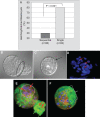Improved Murine Blastocyst Quality and Development in a Single Culture Medium Compared to Sequential Culture Media
- PMID: 26668049
- PMCID: PMC5933093
- DOI: 10.1177/1933719115618281
Improved Murine Blastocyst Quality and Development in a Single Culture Medium Compared to Sequential Culture Media
Abstract
Objective: Validate single versus sequential culture media for murine embryo development.
Design: Prospective laboratory experiment.
Setting: Assisted Reproduction Laboratory.
Animals: Murine embryos.
Interventions: Thawed murine zygotes cultured for 3 or 5 days (d3 or d5) in single or sequential embryo culture media developed for human in vitro fertilization.
Main outcome measures: On d3, zygotes developing to the 8 cell (8C) stage or greater were quantified using 4',6-diamidino-2-phenylindole (DAPI), and quality was assessed by morphological analysis. On d5, the number of embryos reaching the blastocyst stage was counted. DAPI was used to quantify total nuclei and inner cell mass nuclei. Localization of ubiquitin C-terminal hydrolase L1 (UCHL1) and ubiquitin C-terminal hydrolase L3 (UCHL3) was reference points for evaluating cell quality.
Results: Comparing outcomes in single versus to sequential media, the odds of embryos developing to the 8C stage on d3 were 2.34 time greater (P = .06). On d5, more embryos reached the blastocyst stage (P = <.0001), hatched, and had significantly more trophoblast cells (P = .005) contributing to the increased total cell number. Also at d5, localization of distinct cytoplasmic UCHL1 and nuclear UCHL3 was found in high-quality hatching blastocysts. Localization of UCHL1 and UCHL3 was diffuse and inappropriately dispersed throughout the cytoplasm in low-quality nonhatching blastocysts.
Conclusions: Single medium yields greater cell numbers, an increased growth rate, and more hatching of murine embryos. Cytoplasmic UCHL1 and nuclear UHCL3 localization patterns were indicative of embryo quality. Our conclusions are limited to murine embryos but one might speculate that single medium may also be more beneficial for human embryo culture. Human embryo studies are needed.
Keywords: UCHL1; UCHL3; culture; embryo; media.
© The Author(s) 2015.
Conflict of interest statement
Figures




Similar articles
-
Randomized controlled trial of low (5%) versus ultralow (2%) oxygen for extended culture using bipronucleate and tripronucleate human preimplantation embryos.Fertil Steril. 2018 Jun;109(6):1030-1037.e2. doi: 10.1016/j.fertnstert.2018.02.119. Fertil Steril. 2018. PMID: 29935641
-
Increasing glucose in KSOMaa basal medium on culture Day 2 improves in vitro development of cloned caprine blastocysts produced via intraspecies and interspecies somatic cell nuclear transfer.Theriogenology. 2012 Sep 1;78(4):921-9. doi: 10.1016/j.theriogenology.2012.04.009. Epub 2012 Jun 14. Theriogenology. 2012. PMID: 22704387
-
Higher survival rate of vitrified and thawed in vitro produced bovine blastocysts following culture in defined medium supplemented with beta-mercaptoethanol.Anim Reprod Sci. 2006 Jun;93(1-2):61-75. doi: 10.1016/j.anireprosci.2005.06.027. Epub 2005 Aug 11. Anim Reprod Sci. 2006. PMID: 16099115
-
Dissection of culture media for embryos: the most important and less important components and characteristics.Reprod Fertil Dev. 2008;20(1):9-18. doi: 10.1071/rd07160. Reprod Fertil Dev. 2008. PMID: 18154693 Review.
-
Symposium: innovative techniques in human embryo viability assessment. Assessing embryo viability by measurement of amino acid turnover.Reprod Biomed Online. 2008 Oct;17(4):486-96. doi: 10.1016/s1472-6483(10)60234-9. Reprod Biomed Online. 2008. PMID: 18854101 Review.
Cited by
-
Comparison of two commercial embryo culture media (SAGE-1 step single medium vs. G1-PLUSTM/G2-PLUSTM sequential media): Influence on in vitro fertilization outcomes and human embryo quality.JBRA Assist Reprod. 2018 Jun 1;22(2):128-133. doi: 10.5935/1518-0557.20180024. JBRA Assist Reprod. 2018. PMID: 29697926 Free PMC article.
References
-
- Han MS, Niwa K. Effects of BSA and fetal bovine serum in culture medium on develompent of rat embryos. J Reprod Dev. 2003;49(3):235–242. - PubMed
-
- Naaktgeboren N. Quality control of culture media for in vitro fertilisation. Ann Biol Clin (Paris). 1987;45(3):368–372. - PubMed
-
- Oh SH, Miyoshi K, Funahashi H. Rat oocytes fertilized in modified rat 1-cell embryo culture medium containing a high sodium chloride concentration and bovine serum albumin maintain developmental ability to the blastocyst stage. Biol Reprod. 1998;59(4):884–889. - PubMed
-
- Martin PM, Sutherland AE, Van Winkle LJ. Amino acid transport regulates blastocyst implantation. Biol Reprod. 2003;69(4):1101–1108. - PubMed
-
- Bavister BD. Culture of preimplantation embryos: facts and artifacts. Hum Reprod Update. 1995;1(2):91–148. - PubMed
Publication types
MeSH terms
Substances
Grants and funding
LinkOut - more resources
Full Text Sources
Other Literature Sources
Miscellaneous

